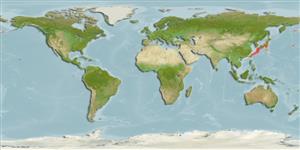Mixini (Missine) (hagfishes) >
Myxiniformes (Hagfishes) >
Myxinidae (Hagfishes) > Eptatretinae
Etymology: Eptatretus: hepta (Gr.), seven; tretos (Gr.), perforated (i.e., with holes), referring to seven gill apertures on what would later be described as Homea banksii (=E. cirrhatus) [range within genus is 6-14 pairs of gill apertures] (See ETYFish); okinoseanus: -anus, Latin adjectival suffix that means, when attached to a name, “belonging to”: Okinose, Honshu Island, Japan, type locality (See ETYFish).
Environment: milieu / climate zone / depth range / distribution range
Ecologia
marino batidemersale; non migratori; distribuzione batimetrica 300 - 1020 m (Ref. 31545). Deep-water
Northwest Pacific: Taiwan (Ref. 5193) and southern Japan.
Size / Peso / Age
Maturity: Lm ? range ? - ? cm
Max length : 80.0 cm TL maschio/sesso non determinato; (Ref. 559)
Gill pouches and gill apertures 8, with the latter arranged in a straight line, loosely spaced (Ref. 31545). Fused cusps 3/2, total cusps 44-49. Total slime pores 87-97. Eyespots present. Ventral finfold well developed. Caudal finfold well developed only from the tip of the tail dorsally to above origin of cloaca (Ref. 51420).
Life cycle and mating behavior
Maturità | Riproduzione | Deposizione | Uova | Fecundity | Larve
Copulatory organ absent. The gonads of hagfishes are situated in the peritoneal cavity. The ovary is found in the anterior portion of the gonad, and the testis is found in the posterior part. The animal becomes female if the cranial part of the gonad develops or male if the caudal part undergoes differentiation. If none develops, then the animal becomes sterile. If both anterior and posterior parts develop, then the animal becomes a functional hermaphrodite. However, hermaphroditism being characterised as functional needs to be validated by more reproduction studies (Ref. 51361 ).
Fernholm, B., 1998. Hagfish systematics. p. 33-44. In J.M. Jørgensen, J.P. Lomholt, R.E. Weber and H. Malte (eds.) The biology of hagfishes. Chapman & Hall, London. 578 p. (Ref. 31276)
IUCN Red List Status (Ref. 130435: Version 2024-2)
Threat to humans
Harmless
Human uses
Pesca: di potenziale interesse
Strumenti
Special reports
Download XML
Fonti Internet
Estimates based on models
Preferred temperature (Ref.
123201): 7.3 - 13.6, mean 9.1 °C (based on 27 cells).
Phylogenetic diversity index (Ref.
82804): PD
50 = 0.5000 [Uniqueness, from 0.5 = low to 2.0 = high].
Bayesian length-weight: a=0.00204 (0.00094 - 0.00444), b=2.93 (2.74 - 3.12), in cm total length, based on LWR estimates for this (Sub)family-body shape (Ref.
93245).
Trophic level (Ref.
69278): 4.3 ±0.7 se; based on size and trophs of closest relatives
Resilienza (Ref.
120179): Basso, tempo minimo di raddoppiamento della popolazione 4.5 - 14 anni (Fec assumed to be <100).
Fishing Vulnerability (Ref.
59153): Moderate to high vulnerability (52 of 100).
